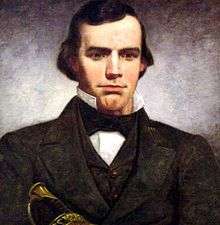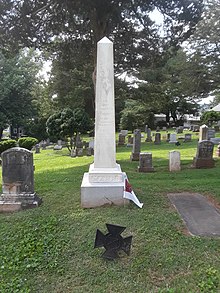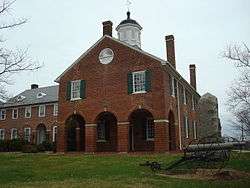John Quincy Marr
John Quincy Marr (May 27, 1825 – June 1, 1861) was a Virginia militia company captain and the first Confederate soldier killed by a Union soldier in combat during the American Civil War. Marr was killed at the Battle of Fairfax Court House, Virginia on June 1, 1861. Previously one of Fauquier County's two delegates to the Virginia Secession Convention of 1861, Marr initially opposed his state's secession from the Union but ultimately supported secession, as did voters shortly before his fatal skirmish.
John Quincy Marr | |
|---|---|
 Marr in 1849 | |
| Born | May 27, 1825 Warrenton, Virginia |
| Died | June 1, 1861 (aged 36) Fairfax Court House, Virginia |
| Buried | |
| Allegiance | |
| Service/ | |
| Years of service | 1861 |
| Rank | |
| Unit | Warrenton Rifles company |
| Battles/wars | American Civil War |
Early life
John Q. Marr was born on May 27, 1825 in Warrenton, Fauquier County, Virginia. He was the son of Catherine Inman Horner Marr (1797-1879) and John Marr, Esq. (1788-1848), who had married in 1816. The elder John Marr was the grandson of a French immigrant with the surname "La Mar." The elder John Marr had been a Commissioner in Chancery in the Supreme and County Courts, much like a court-appointed trustee in later times, as well as a justice of the peace.[1] He owned enslaved black persons,[2] as would his widow and son John Q. Marr by 1860.[3]
John Quincy Marr graduated second in the class of 1846 from the Virginia Military Institute (VMI).[4] However, his father died on June 3, 1848, and his elder brother Robert Athelstan Marr (1823-1854) was a naval officer.[5] Although John Q. Marr taught at VMI as an assistant professor of mathematics and tactics after graduating, he returned home in 1848 to care for his mother and sisters Sarah/Sally (1819-1895), Margaret (1830-1903), Frances (1835-1918) and Jane (1840-1927), since his younger brothers Thomas Scott Marr (1830-1897) and James Ripon Marr (1832-1879) left home by 1850. The local judges gave him the same appointments held by his father; Marr also served a two-year term as sheriff of Fauquier County.[6]
Road to Civil War
After John Brown's raid on Harpers Ferry, Marr organized the "Warrenton Rifles" militia company.[7]
In early 1861, Fauquier County voters elected Marr as a delegate to the Virginia Secession Convention.[8] Although initially opposed to secession, and called home by a "family affliction" during the deliberations, he later signed the ordinance of secession.[9][10]
On May 5, 1861, Marr was commissioned as a lieutenant colonel in the Virginia forces, but he never received the commission because it was sent to Harpers Ferry by mistake.[9]
Death
On Saturday, June 1, 1861,[11] a company of Union Army cavalry on a scouting mission entered the streets of Fairfax Court House after driving back one Confederate picket and taking another prisoner. At that time, two companies of cavalry and Marr's Warrenton Rifles infantry company occupied the town. The Confederate cavalry began to retreat and cut off part of the Warrenton Rifles from those who faced the Union cavalry charge. Only about 40 men from the company were in a position to combat the Union cavalrymen.[9]
Lieutenant Charles Henry Tompkins of the 2d U.S. Cavalry Regiment led the Union force of between 50 and 86 men[12] who separated into two groups as they rode through the village. Captain Marr challenged the riders, asking "What cavalry is that?" These were his last words. Scattered shots were fired as the Union cavalry rode through and Captain Marr fell dead.[9] Marr was not in the immediate presence of any of his men on a dark night so soon after he fell, no one knew where he was or what may have happened to him.[13] His body was found later in the morning.[14][15]
After Marr fell, first appeared former and subsequent Virginia governor and later major general William "Extra Billy" Smith, who had just resigned his seat in the U.S. Congress. He was from Warrenton and had helped raised the company. He took command in the absence of the company's leaders. Soon thereafter Lieutenant Colonel (later Lieutenant General) Richard S. Ewell, who had just been placed in charge of Confederate forces at Fairfax Court House, came upon the company. Lt. Col. Ewell had received a shoulder wound as he emerged from the village's hotel as the Union force first rode through the streets so he was bleeding as he took charge of the infantry company in the field and redeployed 40 of them.[16] Ewell soon went off to send for reinforcements and Smith redeployed the men again in the same general area but in a less exposed position about 100 yards forward.[17][18] After the Union cavalry rode through the village, they regrouped and returned through the village streets. A volley from the redeployed men of the Warrenton Rifles turned them back.[19] The Confederates fired additional volleys at the Federals as they tried to pass through town again on their way back to their base near Falls Church, Virginia.[19] After a third failed attempt to ride past the Confederates, the Union men were forced to leave town toward Flint Hill in the Oakton area of Fairfax County to the north of the City of Fairfax with several wounded men.[20]
Confederate casualties in the affair were one dead, four wounded (including Lt. Col. Ewell), one missing, according to their report.[14] A later account states that only two were wounded, but five were captured.[17] The Union force lost one killed, four wounded (including Lt. Tompkins) and three missing, who had been taken prisoner. The Union soldier killed was identified as Private Saintclair.[21] Governor Smith later reported that Marr had apparently been hit by a spent round ball because he had a large bruise above his heart but his skin had not been penetrated.[22]
Aftermath

Captain Marr's body arrived in Warrenton that evening. The following afternoon a large crowd attended a ceremony in the clerk's office yard before his burial in the Warrenton Cemetery.[14][23][24]
Charles Henry Tompkins received the Medal of Honor for his actions at the 1861 battle. His was the first action of a Union Army officer in the American Civil War for which a Medal of Honor was awarded, though not until 1893.[25][26] His citation reads: "Twice charged through the enemy's lines and, taking a carbine from an enlisted man, shot the enemy's captain."[27] No other account referenced on this page states that Tompkins personally shot Captain Marr.[28]
A monument to Captain Marr was erected on June 1, 1904 near the entrance of the Historic Fairfax County Courthouse, where it remains today. The monument reads: "This stone marks the scene of the opening conflict of the war of 1861–1865, when John Q. Marr, captain of the Warrenton Rifles, who was the first soldier killed in action, fell 800 feet south, 46 degrees West of the spot. June 1, 1861. Erected by the Marr Camp, C.V., June 1, 1904."[19]
First Confederate casualty
Various authors have claimed that Private Henry Lawson Wyatt of the 1st North Carolina Volunteers (later the 11th North Carolina Infantry Regiment), the only Confederate soldier to die at the Battle of Big Bethel, Virginia on June 10, 1861 was the first Confederate soldier killed in Civil War combat. This claim stands only insofar as a distinction is made between the first officer killed, Captain John Quincy Marr, and the first enlisted man killed, which Private Wyatt appears to have been.[29]
Notes
- Walker, Charles D. Memorial, Virginia Military Institute: Biographical sketches of the Graduates and Eleves of the Virginia Military Institute Who Fell in the War Between the States. Philadelphia: J. P. Lippincott & Company, 1875. OCLC 229174667. Retrieved May 11, 2011. pp. 359–360
- 1840 U.S. Federal Census for Leeds, Fauquier County, Virginia shows John Marr as owing 6 or 7 male and 7 female black slaves. The 1850 U.S. Federal census slave schedules for the family may have been misdigitized or missing.
- Virginia's 1860 slave schedules for both Catherine "J" Marr and John "D" Marr of Fauquier County are referenced by ancestry.com, but not available online. The 1860 U.S. Federal Census for the Southwest Revenue District of Fauquier County shows Catherine as owning a 17 year old male and 45 and 19 year old female black slaves. The corresponding 1860 federal census slave schedule for John Q. Marr may have been misdigitized or missing.
- At least one account says Marr was first in the class.
- findagrave numbers 46877736, 154382252. However the elder John Marr's death is listed as occurring in 1846. Their marriage record is not available at ancestry.com, likewise the probate record, and Virginia began compiling death records decades later. Fauquier may have been one of the counties to send its court records to Richmond, where they were burned during the Confederate Evacuation Fire of April 1865.
- Walker, 1875, p. 361
- Captain Marr's company, the Warrenton Rifles, was still a unit of the "Virginia Army," even though the secession of Virginia was ratified by a popular vote on May 23, 1861. Governor John Letcher issued a proclamation transferring Virginia forces to the Confederacy on June 6, 1861 and Major General Robert E. Lee, commanding state forces, issued an order in compliance with the proclamation on June 8, 1861. United States. War Dept, Robert Nicholson Scott, et al. The War of the Rebellion: a compilation of the official records of the Union and Confederate Armies Series I, Volume II. Washington: Government Printing Office, 1880. OCLC 427057. Retrieved May 14, 2011. pp. 911–912. The company became Company K of the 17th Virginia Infantry Regiment when that regiment was organized on June 10, 1861. Wise, 1870, p. 17. The forces at Fairfax Court House were under the command of Lt. Col. Richard S. Ewell of the Provisional Army of the Confederate States. Even before the popular vote on secession in Virginia, the State had agreed that its separate force would cooperate with the Confederacy.
- Walker, 1875, pp. 360–361
- Walker, 1875, p. 363
- All but one of the accounts that mention Marr's marital status say that he was unmarried or do not mention this aspect of his personal life. Poland Jr., Charles P. The Glories Of War: Small Battle And Early Heroes Of 1861. Bloomington, IN: AuthorHouse, 2006. ISBN 1-4184-5973-9. pp. 42–43 says Marr had a wife and six children and a Cherokee mistress named Eliz Nickens with whom he had six more children. He also says that Marr had been mayor of Warrenton. None of the other references for this page confirm these details. Poland's detailed account relies at least in part on a private letter in the Warrenton Public Library for these personal details.
- The report of the Confederate adjutant general for the year ending September 30, 1862 notes the death of Captain Marr but gives the date as May 31, 1861. This can be reconciled in that the Union force left their base at 10:30 p.m. on May 31 and the battle took place on the "night" of May 31, albeit in the early morning hours of June 1, 1861. The entry in the report also states: first blood of the war. Walker, 1875, p. 366
- Walker, 1875, p. 363 says Tompkins had 86 men. Poland Jr., 2006, p. 37, says there were about 50 men in the patrol; he says that Tompkins reported he had 51 men, although he notes that General Irvin McDowell reported that Tompkins had 75, Poland Jr., 2006, p. 82. Longacre, Edward G. Lincoln's Cavalrymen: A History of the Mounted Forces of the Army of the Potomac. Mechanicsburg, PA: Stackpole Books, 2000. ISBN 0-8117-1049-1. p. 18 uses the number of 75 men from McDowell's report for the size of Tompkins's force.
- Wise, George. History of the Seventeenth Virginia Infantry, C. S. A.. Baltimore: Kelly, Piet and Company, 1870. OCLC 1514671. Retrieved May 13, 2011. p. 18
- Walker, 1875, p. 364
- Donald Pfanz in Richard S. Ewell: a Soldier's Life, states that Lt. Col. Ewell challenged the riders with similar words, out of concern that they might be the Confederate horsemen, and was answered with a pistol shot which wounded his shoulder. Pfanz, Donald C. Richard S. Ewell: A Soldier's Life. Chapel Hill: University of North Carolina Press, 1998. ISBN 0-8078-2389-9. p. 127. Other accounts of his wounding state that Ewell was wounded as he emerged from the hotel to find the Warrenton Rifles.
- As noted earlier, Pfanz, 1998, p. 127 states that Ewell was wounded after he took charge of the Warrenton Rifles. Walker, 1875, p. 364 says that Ewell received a wound in the shoulder at the beginning of the fight.
- Poland, 2006, p. 40
- Pfanz says that Ewell deployed the men behind stone walls. Pfanz, 1998, p. 127
- Poland, 2006, p. 82
- Wise. 1870, p. 19
- Moore, ed., Frank. The Rebellion Record: A Diary of American Events. 11 volumes. Volume 1, pp. 321–322. New York: G.P. Putnam, D. Van Nostrand, 1861–1863; 1864–68. OCLC 2230865. Retrieved May 13, 2011
- Poland, 2006, p. 42
- Sifakis, Stewart. Who Was Who in the Civil War, p. 433. New York: Facts On File, 1988. ISBN 0-8160-1055-2. "In a little remembered action at Fairfax Court House, Virginia, John Q. Marr was the only fatality, becoming the first martyr of the Confederacy to die in combat."
- A "Captain" Stephen Roberts, sometimes mistakenly identified as Christian Roberts, is mentioned in a few accounts as the first "armed Confederate officer" killed in the Civil War. He was killed by a small patrol of the Union 2d Virginia (U.S.) Infantry Regiment (later the 5th West Virginia Cavalry Regiment) led by Lt. Oliver R. West at Glover's Gap, Virginia (later West Virginia) on May 28, 1861. West and six men were sent to arrest certain local rebels who were suspected of cutting telegraph wires and tearing up railroad tracks about midway between Wheeling and Grafton, Virginia. Although Roberts was a local secessionist leader and his "company" intended to join the Confederate forces within a few days, the more detailed and convincing accounts (and the ones that got Roberts's first name right) state that he was not a regularly enrolled or mustered in officer but in effect was a freelance secessionist militiaman at the time of his death. They say his men disbanded thereafter. Leib, Charles. Nine months in the quartermaster's department: or, The chances for making a Million. Cincinnati: Moore, Wilstach, Keys & Co., 1862. OCLC 1113021 Retrieved May 20, 2011. p. 11; Wheeling Daily Intelligencer, May 30, 1861. It appears that Roberts, like Jackson, must be considered a civilian at the time of his death.
- Longacre, Edward G. Lincoln's Cavalrymen: A History of the Mounted Forces of the Army of the Potomac. Mechanicsburg, PA: Stackpole Books, 2000. ISBN 0-8117-1049-1. p. 19
- Private Francis E. Brownell was awarded the Medal of Honor for his action in killing James W. Jackson (middle initial sometimes given as "T"), the man who had just killed Colonel Elmer E. Ellsworth at Alexandria, Virginia on May 24, 1861. His award also was received considerably later, in 1877. His was the first action for which the Medal of Honor was awarded. Sifakis, 1988, p. 81
- "Medal of Honor recipients Civil War (M-Z)". United States Army Center of Military History. Archived from the original on 2009-02-23. Retrieved 2011-05-15.
- Poland, 2006, p. 83 says that a rumor began to circulate that Marr had been shot by his own men but that the consensus became that he was killed by a stray shot from a Union trooper. Governor Smith agreed with this view. Longacre, 2000, pp. 19–20 and Pfanz, 1998, p. 128 also give the stray shot account.
- Norris, David. The Battle of Big Bethel pp. 226–227 In Encyclopedia of the American Civil War: A Political, Social, and Military History, edited by David S. Heidler and Jeanne T. Heidler. New York: W. W. Norton & Company, 2000. ISBN 0-393-04758-X
References
- Leib, Charles. Nine months in the quartermaster's department: or, The chances for making a Million. Cincinnati: Moore, Wilstach, Keys & Co., 1862. OCLC 1113021 Retrieved May 20, 2011.
- Longacre, Edward G. Lincoln's Cavalrymen: A History of the Mounted Forces of the Army of the Potomac. Mechanicsburg, PA: Stackpole Books, 2000. ISBN 0-8117-1049-1.
- Moore, ed., Frank. The Rebellion Record: A Diary of American Events. 11 volumes. New York: G.P. Putnam, D. Van Nostrand, 1861–1863; 1864–68. OCLC 2230865. Retrieved May 13, 2011.
- Norris, David. The Battle of Big Bethel pp. 226–227 in Encyclopedia of the American Civil War: A Political, Social, and Military History, edited by David S. Heidler and Jeanne T. Heidler. New York: W. W. Norton & Company, 2000. ISBN 0-393-04758-X.
- Pfanz, Donald C. Richard S. Ewell: A Soldier's Life. Chapel Hill: University of North Carolina Press, 1998. ISBN 0-8078-2389-9.
- Poland Jr., Charles P. The Glories Of War: Small Battle And Early Heroes Of 1861. Bloomington, IN: AuthorHouse, 2006. ISBN 1-4184-5973-9.
- Sifakis, Stewart. Who Was Who in the Civil War. New York: Facts On File, 1988. ISBN 0-8160-1055-2.
- United States. War Dept, Robert Nicholson Scott, et al. The War of the Rebellion: a compilation of the official records of the Union and Confederate Armies Series I, Volume II. Washington: Government Printing Office, 1880. OCLC 427057. Retrieved May 14, 2011.
- Walker, Charles D. Memorial, Virginia Military Institute: Biographical sketches of the Graduates and Eleves of the Virginia Military Institute Who Fell in the War Between the States. Philadelphia: J. P. Lippincott & Company, 1875. OCLC 229174667. Retrieved May 11, 2011.
- Wise, George. History of the Seventeenth Virginia Infantry, C. S. A.. Baltimore: Kelly, Piet and Company, 1870. OCLC 1514671. Retrieved May 13, 2011.
